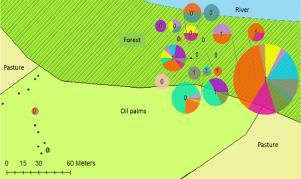Acta Tropica ( IF 2.1 ) Pub Date : 2020-08-20 , DOI: 10.1016/j.actatropica.2020.105674 Johan M Calderón 1 , Diana Erazo 2 , Troy J Kieran 3 , Nicole L Gottdenker 4 , Cielo León 1 , Juan Cordovez 2 , Felipe Guhl 1 , Travis C Glenn 3 , Camila González 1

|
Chagas disease is a zoonosis that affects several million people and is caused by the parasite Trypanosoma cruzi, which is mainly transmitted through the feces of triatomine bugs. Within triatomines, several Rhodnius species have been found inhabiting palms, and certain factors such as palm species and location have been related to the abundance and T. cruzi infection of those insects in palms. In this study, the main goal was to determine if R. prolixus abundances and infection rates in Attalea butyracea and Elaeis guineensis palms are related to ecological factors such as palm species, crown microclimate, and available blood meal sources. Triatomine sampling was performed in two municipalities of Casanare, Colombia, specifically in the intersection of riparian forests and oil palm plantations. For R. prolixus abundance per palm, the predictors showing more relationship were palm species and blood meal species identified in the palm, and for T. cruzi infection per triatomine, they were palm species and nymphal stage. Palm microclimate was very similar in both palm species and did not show a relationship with triatomine abundance. Comparing palm species, A. butyracea showed more blood meal species, including more refractory host species, than E. guineensis, but lower T. cruzi infection rate and parasitaemia. Interestingly, non-arboreal blood meal species were frequently found in the analyzed nymphs, indicating that the blood source for R. prolixus in palms corresponded to all the fauna located in the surrounded landscape and not only in the palm. These results could expose a new ecological scenario to interpret the T. cruzi transmission in sylvatic environments.
中文翻译:

小气候变量和血粉来源如何影响Buttales butyracea和Elaeis guineensis棕榈中的Rhodnius prolixus丰度和creditpanosoma cruzi感染?
恰加斯病是一种人畜共患病,可感染数百万人,是由寄生虫克氏锥虫引起的,克氏锥虫主要通过三atomine臭虫的粪便传播。在三藻类植物中,发现有几种Rhodnius物种栖息于棕榈中,并且某些因素(例如,棕榈物种和位置)与这些昆虫在棕榈中的丰度和克鲁氏锥虫感染有关。在这项研究中,主要目的是确定Buttales butyracea和Elaeis guineensis中的R. prolixus丰度和感染率棕榈与生态因素有关,例如棕榈种类,树冠微气候和可利用的血粉来源。在哥伦比亚卡萨纳雷的两个城市中,特别是在河岸森林和油棕种植园的交汇处,进行了三松碱采样。对于每棵棕榈的螺旋藻丰度,显示更多关系的预测因子是在棕榈中鉴定出的棕榈物种和血粉物种,而对于每个三氢精氨酸的克鲁维氏菌感染,它们是棕榈物种和若虫期。两种棕榈物种的棕榈小气候都非常相似,并且与三氟精氨酸含量没有关系。与棕榈种相比,丁香假单胞菌显示的血粉种类多于几内亚大肠杆菌,包括更多的难治宿主种。,但可降低克鲁氏锥虫感染率和寄生虫血症。有趣的是,在分析过的若虫中经常发现非树状血粉物种,这表明棕榈中螺旋螺的血源与周围环境中的所有动物相对应,而不仅是棕榈中。这些结果可能会揭示一个新的生态学场景,以解释在缓和环境中的克氏锥虫传播。











































 京公网安备 11010802027423号
京公网安备 11010802027423号